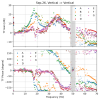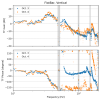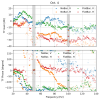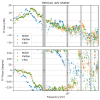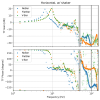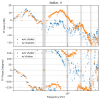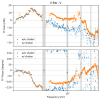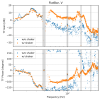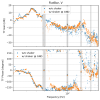[Takahashi, Takano, Komori]
We measured additional transfer functions with the lower two stages of the stack connected.
In addition, we compared the spectra of the two sensors by placing both on the floor.
These data were used to compensate for the sensor differences when measuring the stack's transfer functions.
The vertical transfer functions and corresponding coherence are shown in Fig. 1 and 2, respectively.
The original transfer function of the three-stage stack has a second resonance around 70–80 Hz (red).
As reported yesterday, we successfully shifted this resonance to 120 Hz, as expected, by connecting the upper two stages (green).
On the other hand, as expected, the second resonance remains by connecting the lower two stages (magenta).
In these models, the Q-values were tuned to fit the measured data to the modeled curves.
The horizontal transfer functions and corresponding coherence are shown in Fig. 3 and 4, respectively.
The coherence disappears above 20 Hz, likely due to couplings from other degrees of freedom.
Although we cannot draw reliable conclusions from this measurement, there are no significant excesses above 0 dB in the most critical frequency region (60–200 Hz). Considering both the better isolation of the OMC suspension and the better common mode rejection of the OMC monolithic structure, horizontal seismic noise should not be a significant issue compared to the vertical one.
These measurements were performed at TAMA instead of the KAGRA OMC, but the resonant frequencies are similar.
I would like to propose following tasks related to the KAGRA OMC stack:
- Connect the upper two stages and confirm whether the shifted resonance above 100 Hz does not cause any adverse effects.
- If the shifted resonance introduces new noise, we can attempt to connect all three stages and evaluate the resulting noise levels.
On a related note, rubbers are often modeled as a combination of parallel and series springs/dampers.
(e.g. https://lup.lub.lu.se/search/files/160169822/web1009.pdf )
This model could explain the larger spring constants at AC than that at DC, as currently observed.
We will investigate this further.















































